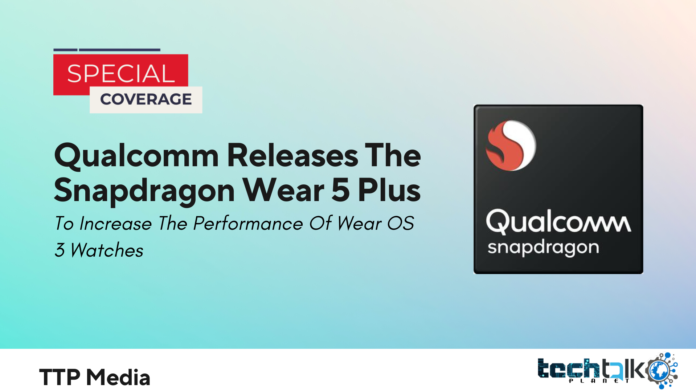
The vast majority of Wear OS watches now on the market are powered by Snapdragon Wear processors from Qualcomm, yet the platform has never really delivered. Due in major part to Snapdragon Wear processors, which are recycled mobile CPU designs based on outdated technology, the current generation of Wear OS watches has suffered greatly. But today Qualcomm is releasing the new wearables platform, the Snapdragon W5 Plus and W5. Furthermore, it seems like Qualcomm this time was serious.
The Snapdragon Wear branding is the first thing the company is getting away with. It might seem minor, but this is more of a metaphorical fresh beginning. Instead, the new W5 Plus and W5 CPUs will be a part of the Snapdragon family. While the W5 Plus is made for premium smartwatches, the W5 is made for simpler devices like fitness trackers, kids’ smartwatches, and business gadgets. In addition, according to Pankaj Kedia, global head of smart wearables at Qualcomm, these CPUs were developed specifically for wearable technologies. In other words, they aren’t smartphone chips.
Regarding specs, the platform keeps the hybrid architecture seen in the Snapdragon Wear 3100 and 4100 CPUs. There is a primary processor for interactive tasks in addition to an always-on coprocessor to help with battery conservation. For the W5 Plus, Qualcomm is dramatically reducing the coprocessor’s size from 28nm to 22nm and the core chip’s size from 12nm to 4nm. For comparison, Samsung’s Exynos W920 uses 5nm manufacturing technology and is used in the Galaxy Watch 4. The S7 chip in the Apple Watch Series 7 is created utilising 7nm technology. This is not meant to imply that the W5 Plus is inherently superior because it uses a 4nm process; rather, it is meant to demonstrate that Qualcomm is now implementing cutting-edge process technology, much like its rivals.
With the W5 Plus platform, functions that were previously handled by the core SoC are now powered by the always-on coprocessor. They offer audio, Bluetooth 5.3 notifications that need little battery, and keyword recognition for digital assistants. The coprocessor also controls features for tracking one’s health, such as monitoring sleep and heart rate. It will be fascinating to observe whether and how businesses use embedded machine learning, despite Kedia’s promise that the coprocessor can enable it.
In essence, interactive functions like GPS navigation, 3D watch faces, and calling are the key uses of the main CPU. According to a press release from Qualcomm, this results in a 50% gain in battery life, a doubling of performance, and a 30% reduction in size compared to the 4100 platforms. The multi-day battery life that Kedia believes the W5 Plus platform would be able to provide in some situations has not yet been achieved by a Wear OS watch. According to Kedia, Bluetooth watches with a 300mAh battery and an always-on display would have an additional 15 hours of battery life. Since Qualcomm’s own research formed the basis of these numbers, it is now difficult to say how they would apply, for instance, to a genuine Fossil timepiece.
According to Kedia, the smaller chip size and increased power efficiency will enable watchmakers to create more nimble, slimline clocks. If true, this is fantastic news for people with little wrists. When incorporating more advanced features, businesses frequently increase battery capacity to offset the increased power usage. In fact, the size of smartwatches has increased over time steadily but gradually. The nearly inevitable existence of a larger Samsung Galaxy Watch 5 Pro is one such instance.
The biggest change is probably that there won’t be much of a wait before the first watches with the Snapdragon W5 are released. Oppo claims to be the first company to release a watch on the W5 platform with the Oppo Watch 3. The W5 Plus chip, according to Mobvoi, will be utilised in the autumn launch of the company’s new TicWatch.
That’s a huge departure from the past. For instance, it took until the fall of 2019 for wearable device makers to embrace the Snapdragon Wear 3100 platform broadly. The lag was even greater while utilising the Snapdragon Wear 4100 platform. Just two smartwatches have it a year after its debut, despite the fact that it was revealed in the summer of 2020. There aren’t many smartwatches on the market right now that run on the 4100.
The introduction of Wear OS 3 wasn’t great, and it’s still unclear how it will work on smartwatches built by companies other than Samsung. The only Wear OS 3 smartwatch that is now widely available is the Samsung Galaxy Watch 4 series. A last-generation 4100 CPU powers the freshly introduced, exorbitantly priced Montblanc Summit 3. It is the first wristwatch to run Wear OS 3 that isn’t a Samsung model. Meanwhile, rumours suggest that the next Google Pixel Watch will be powered by an old Samsung CPU. Therefore, we won’t fully understand the capabilities of a Wear OS 3 watch powered by a contemporary Qualcomm chip until Mobvoi’s W5 Plus-powered TicWatch launches this autumn.
The transition to Wear OS 3 was always going to be challenging, but it also appears like things are finally coming together. Samsung and Google began tackling the software element of the issue last year by creating an integrated software platform. Presently, it looks that Qualcomm is introducing new hardware. But Qualcomm has a track of of dissatisfying customers. However, given the substantial progress in branding, process technology, and the shortened launch period, perhaps Qualcomm will be successful this time.














































